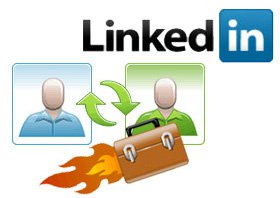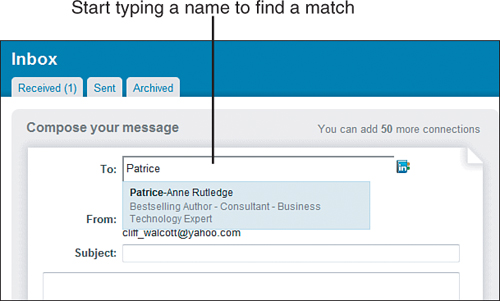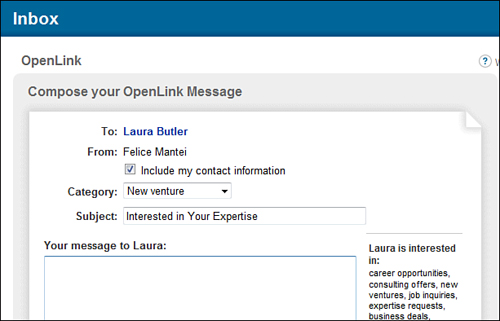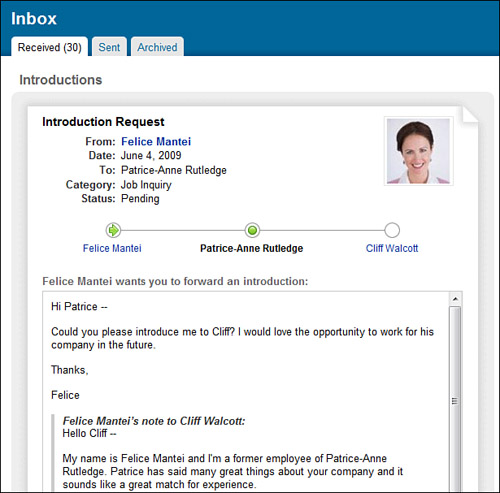Communicate with LinkedIn members
 Network Management - In this tutorial, we will introduce you to the basics of LinkedIn and some ways to communicate with other members of this social network.
Network Management - In this tutorial, we will introduce you to the basics of LinkedIn and some ways to communicate with other members of this social network.
Introduce LinkedIn network
Before starting to communicate with other users on LinkedIn, you need to understand how LinkedIn classifies its members as their connections to them. This feature is important because it will determine what limitations LinkedIn provides for your communication with people.
The LinkedIn network consists of three connection levels:
- Connection level 1 : LinkedIn members you connect directly. You sent them a connection invitation and they accepted the invitation, or you accepted their invitation. Your connection list on the profile will show level 1 connections. When it comes to 'your connections', that means your level 1 connections.
- Level 2 connections : LinkedIn members connect directly to level 1 connections.
- Connection level 3 : LinkedIn members connect directly to level 2 connections.
For example, if you connect directly with your colleague (the name of this colleague is Huong), then Huong is your level 1 connection. If Huong connects directly with the Line, then the Line is connected to level 2. If the Line is directly connected to Son, then Son will now be level 3 connection.
LinkedIn also considers members of groups as part of your network.
Tip : See your network statistics
Introduce InMail, recommendations and messages from LinkedIn
LinkedIn offers a number of ways to communicate with other members. The type of communication you can send depends on how you connect with these members. Your options include:
- Messages - Messages. Messages are the primary form of communication on LinkedIn. You can send messages to your direct connections as well as to LinkedIn teammates like you. If you can send a message to someone, the Send Message link will appear next to their name on the profile and in the search results.
- Invitations - Invitations. An invitation is a request to connect to another LinkedIn member.
- InMail. An InMail is a private message to or from a LinkedIn member that is not your connection. You can get InMail for free if you allow to receive InMail messages on the Account & Settings page. Usually, sending InMail is a feature that LinkedIn requires to pay unless the recipient is a premium member, who are in the OpenLink Network.
- Introduction - Introductions. An introduction provides a way for you to connect with people who are connected to your connections. By asking for a referral through someone you know, that person can refer you to the people you want to contact. You can contact your level 1 connections to ask them to refer members to level 2 and 3 connections. Each member with a free account can have up to 5 referrals at a time. point.
About contact options
Before starting to communicate with another LinkedIn member, you need to understand the options available for contacting someone. When you view the member profile or their summary information from another part of the site, the icons next to the member's name will tell you how you are connected (see Figure 1).

Figure 1: Icons next to the member name tell you how
how are you connected
These symbols are distinguished by level 1, 2 and 3 connections; group members; and those with LinkedIn premium accounts.
Note : Some members of LinkedIn do not have icons
Members who do not display icons next to their names are out of your network members, do not share with these groups, and are not premium account holders.
The links shown to the right of the member name tell you the available contact options.
- Send Message. Send a message to a direct connection or group member.
- Send InMail. Send an InMail to someone who is not in your network. This option does not appear for members you can send messages. If you click on the Send InMail link and don't have a premium account, LinkedIn will prompt you to register for a premium account before doing your job.
- Send InMail (Free). Send an OpenLink message to an OpenLink Network member. LinkedIn members with premium accounts can give you the option to send them InMail for free.
- Get Introduced Through a Connection. Request a referral for this user via a level 1 connection.
- Thêm [đầu tiên của tên] để mạng. Send a connection invitation.
- Forward This Profile to a Connection. Forward a member profile to another member you know, like an intimate introduction.
Many link names appear on a profile. The link names in the search results are sometimes abbreviated.
Note : Not all options are available for all members.
It should be noted that you will never see all these options for any member. For example, unable to send InMail, request a referral or add to your network a member who is already your connection, then these options will not appear for your connections.
Inbox management
Inbox is a focal point for all your direct communication on LinkedIn. The 5 most recent Inbox items will appear above your home page. You can click the Inbox link on the left navigation menu to open the Inbox page, shown in Figure 2.

Figure 2: Your inbox is a focal point for personal media on LinkedIn.
The default view of the Inbox is the Received tab, which displays all the items you have received. If there are multiple Inbox items and want to filter what you need to see, click the down arrow next to the Received header and select one of the available options. For example, you can only display action items, messages, InMail, referrals, invitations, jobs, incentives, or group messages.
Tip : Search for specific content
In addition to filtering Inbox items, you can also search for a specific message. Enter a keyword in the text box on the right side of the page and click the Search Inbox button. LinkedIn will display all messages containing that search term. For example, you can search for a person name or a word or phrase in the subject line or body of the message.
From Received tab, you can
- Classify messages . Click on one of the message headers (From, Subject, Status, or Date) to classify based on that title.
- Store messages . Check the checkbox to the left of the message you want to move to the archive folder and click the Archive button. You should save old messages to one location so that the Inbox only contains your current action items.
Note : You cannot delete messages from your Inbox
LinkedIn does not allow you to delete messages from Inbox. If you want to remove them, you need to store the messages you don't need to see anymore.
- Mark a read or unread message . By default, new messages appear as bold text to distinguish between unread messages. After reading the message, the bold type in your Inbox will be lost. To change this, select the checkbox to the left of the message and click the Mark Read or Mark Unread button .
- Mark the flag for a message with the next action item . By default, new messages will have a flag icon to the right of the subject line, marking it as an action item. Click on the flag icon you can flag or uncheck the flag for a message.
Inbox also includes two other tabs. The Sent tab displays all messages sent and the Archived tab displays all the messages you have received.
Each message also has a status. When a new message arrives, its status will be displayed as Pending . Based on the action you take on each message, your status will change. Status options include:
- Accepted. You have accepted the message, such as a connection invitation.
- Bounced. The message was bounced when sent to the email provider.
- Don't Know / Doesn't Know. The message, such as a connection invitation, is rejected when the recipient clicks the I Don't Know This User button . LinkedIn will list its status as " Don't Know " if you have clicked this button. The status of " Doesn't Know " if you have sent a rejected request.
- In Progress. Distinguishing an InMail or a referral request is still an action item for one of the related people.
- Replaced. Other messages have replaced this message and you will not be able to respond to it. For example, someone has sent you a request for recommendation and then sent it back when you didn't respond.
- Replied. You answered a message.
- Sent. You have answered this message. If the message is a request, the recipient has not yet accepted it.
- Withdrawn. The sender cancels this message, request or invitation.
You can also send messages directly from Inbox. Click the Compose Message button to open the Compose Your Message page and send a message to a connection. For other options, click the upper-right arrow at the right of the Compose Message button. From the drop down list, you can choose:
- Send a message to a connection (similar to clicking the Compose Message button)
- Send InMail or an introduction
- Send an invitation
- Send a recommendation
- Request a recommendation
- Submit a job notification
Send Message
To send a message to a level 1 or group member connection, follow the steps below:
- Click the Compose Message link on the left navigation menu to open the message editor page (Compose Your Message), as shown in Figure 3.

Figure 3: Send a message directly to one of your LinkedIn connections.
- In the To field, type your connection name and wait for LinkedIn to find the match.
Tip : Send a message to multiple connections .
Alternatively, click the address book icon to open your connection list. With the address book, you can search for someone you want to communicate with or choose multiple recipients with your message. LinkedIn allows you to send a message to 50 connections at a time.
- Enter the subject of the message
- Enter your message in the body
- If you send a message to multiple recipients and do not want to expose this information, remove the previous check mark Allow Recipients to See Each Other's Names and Email Addresses (this option is selected by default).
- To email yourself a copy of your message, select the Send Me a Copy checkbox. However, your message will always appear in the Sent folder section by default.
- Click the Send button. LinkedIn will send your message to the recipient and inform you that the message has been sent.
Although clicking on the Compose Message link is the main way of sending messages on LinkedIn, however, in addition to that, you can still send your messages by clicking on the Send Message link in a profile. , on the home page or in the search results page.
Tip : Some ways to contact LinkedIn members.
Read and reply to messages
You can open messages from the Inbox preview on your home page or from the Inbox itself. (Access to it by clicking the Inbox link on the left navigation menu).
Click the subject line link of any message to open it. Figure 4 illustrates you a sample message.

Figure 4: View messages and reply
The buttons that appear at the bottom of the message vary depending on the type of message and the actions you take. For example, a basic message will include a Reply button, a recommendation request that includes a Write a Recommendation button, a connection invitation that includes the Accept and I Don't Know This User buttons.
Send InMail
As mentioned above, InMail allows you to contact members who are not in your network. To manage spam, LinkedIn requires members to pay for InMail sending. InMail is most useful for members who want to communicate with many people, such as a new member or individual individuals using LinkedIn for business development.
LinkedIn premium accounts allow you to send a fixed number of messages during the month. To learn about LinkedIn and InMail premium accounts, you need to click the Upgrade Your Account link at the bottom of the navigation menu. You can also buy an InMail for $ 10. To do so, click the Account & Settings link at the top of the navigation menu, then click the Purchase link in the Account section. This is a cost effective provided that you want to contact some people with InMail.
Tip : When you can send an InMail for free
If you see the word "Free" immediately following the Send InMail link, then you can send an InMail to this LinkedIn member without any extra charge. To allow members to send InMail for free, you must participate in the OpenLink Network, which is a premium feature .
To determine which InMail options are available for a certain member, see the contact options on that person's profile (see Figure 5).

Figure 5: Identify InMail options for a LinkedIn member.
To send an InMail to a LinkedIn member, follow the steps below:
- Click the Send InMail link in the profile of the person you want to contact them. If you send an InMail extra fee, the Compose Your Message page will appear. If you send a free InMail, the Compose Your OpenLink Message page will appear. These pages contain identification information.

Figure 6: Send a free InMail to members of the OpenLink Network
- If you do not want to share your contact information with anyone else you want to connect to, remove the checkmark in the Include My Contact Information checkbox (selected by default).
- In the Category drop-down list, select your reason for InMail. The options here include job opportunities, advice, new challenges, job requirements, advice requests, . stay in touch.
- In the Subject field, enter your InMail subject.
- In the body of the message, enter your message content.
- Click the Send button to send your InMail. If the recipient does not respond to InMail within 7 days, the message will expire.
Tip : Some ways for InMail
Request a referral
Requesting an introduction is a good way to connect with someone who doesn't connect directly to your network. Although you can send an invitation to connect to someone you don't know, you need to consider requesting an introduction through a shared connection for important contacts. A referral can be a lot more weight than you can invite yourself to connect.
For example, suppose you were connected to a former director A (this is a level 1 connection) and Mr. A connected with Mr. B (second-level connection), a manager of a company. near. Your intention is to find out about this job in Mr. B 's room and ask to work there, you don't know him and still haven't seen any signs of work. In this case, instead of sending Mr. B an email directly from you, you can send a referral request through Mr. A.
Normally you will know how to connect with someone you want to contact, but you can also determine this by watching How You're Connected To on the profile of the target contact. If you don't know a connection, this information box may list names so you can identify them.
Here are some tips for creating LinkedIn recommendations:
- Talk to the level 1 connection before submitting a referral request on LinkedIn. Your connection may have information relevant to the requirements you are interested in. For example, if you want to contact someone about job opportunities, your connection may want to know whether your goal is to hire or need a more suitable person to contact.
- Focus on the introductions to level 2 connections to get the best results. Although you can request an introduction to a level 3 connection, this request will require two intermediaries and it will make the request less effective.
- Create a brief and specific introduction request. An unclear request to get to know someone will make it ineffective for achieving your goal, such as finding a job, recruiting for a new job, providing counseling services, .
- Keep in mind that you only have 5 introductory introductions at a time with your free LinkedIn personal account. You can know the number of referrals you have by clicking the Account & Settings link in the upper part of the navigation menu and viewing the summary of the account. To increase the number of open referrals, you need to upgrade to your account to be a premium account. LinkedIn advises you to use introductions wisely rather than as a tool for communicating with hundreds of members.
To request an introduction, follow these steps:
- Click the Get Introduced Through a Connection link on the profile of the person you want to contact them. The Introductions page will appear, see Figure 7.

Figure 7: Ask for an introduction to someone whose connection knows.
Tip : Some ways to request an introduction
You can request an introduction by clicking the Get Introduced link in the search results page or the group member list.
- If you do not want to share your contact information with the person you want to contact them, remove the checkmark in the Include My Contact Information checkbox (defaulted).
- From the Category list drop down, select the reason for your referral request.
- In the Subject field, enter the subject of the request.
- In the first text, enter the text of the message to the person you want to be introduced to.
- In the second text, enter a brief note to the person you want to create trust (connect your level 1).
- Click the Send button to submit your referral request.
Your level 1 connection will receive your request and can forward it to the target connection along with comments or reject your request. If the request is not clear, your connection may require you to provide more information.
Manage referral requests
In addition to requesting your own referrals to others, you can also receive referral requests. For example, LinkedIn members may ask you to refer someone to your connections or may require your connection to introduce you.
To review and respond to referral requests, follow the steps below:
- Click the Inbox link on the left navigation menu to open your Inbox.
- If you have multiple messages in Inbox, select Introductions from the Received drop-down list. Your inbox only displays referral requests. Alternatively, you can view new referral requests in your Inbox preview on the homepage or receive them by email.
- To open the request, click on the subject line link. Figure 8 illustrates a sample introduction request.

Figure 8 Forward a referral request to someone in your connections.
- Click the Forward Introduction button to forward the request to your connection.
Note : Rejecting or storing a referral request
If you don't want to make an introduction, click the Decline Introduction button. Alternatively, you can click the Archive button to transfer the request to your Archive folder, which is where you can take action for later requests. Referral requests will be kept active for a period of 6 months.
- Enter additional comments in the text and click the Forward Message button .
The target recipient will receive your forwarded referral request and can accept, reject, or store it. Accepting an introduction allows the requester and the target to communicate with each other, however, they still need to send a request to become connections.
Conclude
In this tutorial, we have shown you some ways to communicate with other LinkedIn members as well as the options available based on their connection to you.
You should read it
- 9 misunderstand about social networks
- 3 steps to attract employers on LinkedIn
- 6 AI-powered features on LinkedIn you may not know
- How to Protect Your Kids on Social Media
- 5 social media trends in 2014
- LinkedIn privacy settings
- Remember 9 things you should limit sharing on social networks
- 5 tips to help you use LinkedIn better
- Top 10 social networks to replace Facebook (part 2)
- Pros and cons of using social media to find work
- The best time frame to post to social networks
- Microsoft integrates LinkedIn with Word to make writing applications easier






 5 tips to help you use LinkedIn better
5 tips to help you use LinkedIn better LinkedIn privacy settings
LinkedIn privacy settings Instructions for creating a LinkedIn account
Instructions for creating a LinkedIn account Microsoft released a completely new LinkedIn application for Windows 10
Microsoft released a completely new LinkedIn application for Windows 10 What is the standard LinkedIn image size?
What is the standard LinkedIn image size? 6 AI-powered features on LinkedIn you may not know
6 AI-powered features on LinkedIn you may not know